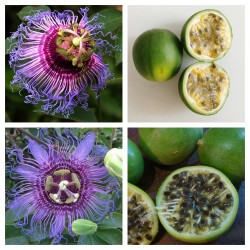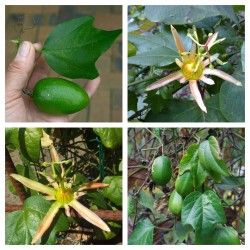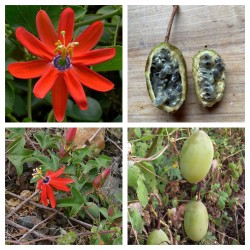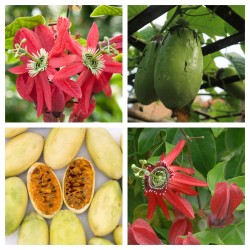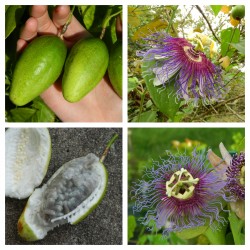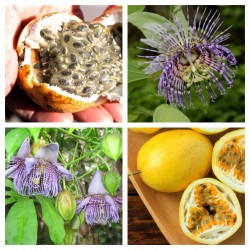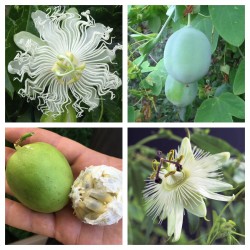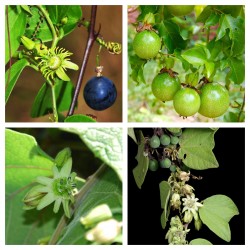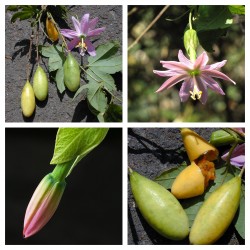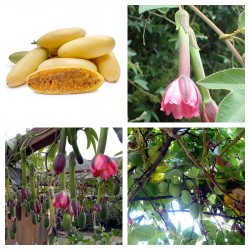Seeds Gallery EU,
5/
5
<h2><strong>Oak Leaved Papaya Seeds (Carica quercifolia)</strong></h2>
<h2><span style="color: #fc0000;"><strong>Price for Package of 3 seeds.</strong></span></h2>
<p><span style="color: #000000; font-family: Verdana, Arial, Helvetica, sans-serif; font-size: 12.8px; float: none; display: inline;">The Oak Leaved papaya tree is a small, but a fast-growing plant that generally reaches heights of 5 to 8 meters tall. The tree’s name-sake leaves are a glossy green and have 5 to 7 deeply serrated fingers that, not surprisingly, resemble those of an oak tree. The small fruits are 3 to 5 centimeters long and have an elongated oval shape with a slightly tapered tip. They grow on sturdy stems in small clusters and have gold to peachy-orange exterior. Inside the thin edible skin is an orange pulpy flesh that has a sweet musky flavor with rich tropical notes. The fruits are filled with numerous blackish-green seeds that are edible but pack a strong peppery watercress-like flavor.</span><br style="color: #000000; font-family: Verdana, Arial, Helvetica, sans-serif; font-size: 12.8px;" /><br style="color: #000000; font-family: Verdana, Arial, Helvetica, sans-serif; font-size: 12.8px;" /></p>
<h2 style="display: inline; color: #004000; font-size: 1.2em; font-family: Verdana, Arial, Helvetica, sans-serif;">Seasons/Availability<br /><span style="color: #000000; font-family: Verdana, Arial, Helvetica, sans-serif; font-size: 12.8px; float: none; display: inline;">Oak Leaved papayas are available year-round with peak season in the late summer and fall.</span><br style="color: #000000; font-family: Verdana, Arial, Helvetica, sans-serif; font-size: 12.8px;" /><br style="color: #000000; font-family: Verdana, Arial, Helvetica, sans-serif; font-size: 12.8px;" /></h2>
<h2 style="display: inline; color: #004000; font-size: 1.2em; font-family: Verdana, Arial, Helvetica, sans-serif;">Current Facts<br /><span style="color: #000000; font-family: Verdana, Arial, Helvetica, sans-serif; font-size: 12.8px; float: none; display: inline;">The Oak Leaved papaya is a variety of mountain papaya known botanically as Carica quercifolia. A member of the Caricaceae, or Papaya family, it is also known as Fig tree of the Mount, Mamón of the Mount, Higuera del Monte, and Mamón del Monte. The Oak Leaved papaya is not usually grown commercially due to its small fruit size and high seed content but is often valued as an ornamental plant with its large showy leaves. With one look at the tree’s uniquely shaped leaves, it is no wonder how it got its name. They are remarkably similar to those of an oak tree but much sturdier and larger in size.</span><br style="color: #000000; font-family: Verdana, Arial, Helvetica, sans-serif; font-size: 12.8px;" /><br style="color: #000000; font-family: Verdana, Arial, Helvetica, sans-serif; font-size: 12.8px;" /></h2>
<h2 style="display: inline; color: #004000; font-size: 1.2em; font-family: Verdana, Arial, Helvetica, sans-serif;">Nutritional Value<br /><span style="color: #000000; font-family: Verdana, Arial, Helvetica, sans-serif; font-size: 12.8px; float: none; display: inline;">Like all papaya varieties, the Oak Leaved papaya contains a tenderizing compound known as papain. This naturally occurring enzyme has been used for thousands of years in its native home of South America and is now widely sold in powder form. The fruits are also rich in vitamins A and C, calcium, phosphates, magnesium, and iron.</span><br style="color: #000000; font-family: Verdana, Arial, Helvetica, sans-serif; font-size: 12.8px;" /><br style="color: #000000; font-family: Verdana, Arial, Helvetica, sans-serif; font-size: 12.8px;" /></h2>
<h2 style="display: inline; color: #004000; font-size: 1.2em; font-family: Verdana, Arial, Helvetica, sans-serif;">Applications<br /><span style="color: #000000; font-family: Verdana, Arial, Helvetica, sans-serif; font-size: 12.8px; float: none; display: inline;">Oak Leaved papayas are usually eaten raw, and be used similarly to their Hawaiian and Mexican cousins. However, their high seed to pulp ratio makes them a tedious fruit to prepare and are therefore best in small amounts. Their miniature and almost decorative tear-drop shape make them a well-suited garnish, especially when split open revealing their jewel-like seeds. Oak Leaved papayas compliments other tropical flavors such as banana, passionfruit, kiwi, pineapple, guava, mango, citrus, and chile peppers, especially jalapeno and serrano.</span><br style="color: #000000; font-family: Verdana, Arial, Helvetica, sans-serif; font-size: 12.8px;" /><br style="color: #000000; font-family: Verdana, Arial, Helvetica, sans-serif; font-size: 12.8px;" /></h2>
<h2 style="display: inline; color: #004000; font-size: 1.2em; font-family: Verdana, Arial, Helvetica, sans-serif;">Geography/History<br /><span style="color: #000000; font-family: Verdana, Arial, Helvetica, sans-serif; font-size: 12.8px; float: none; display: inline;">The Oak Leaved papaya is native to the Andes mountains of Argentina, Bolivia, Peru, Paraguay, Brazil, and Uruguay. They are suited for tropical and subtropical climates but can withstand temperatures as low as 20 degrees F. A hardy easy-to-grow tree, the Oak Leaved papaya thrives in most soil types as long as rainfall is not excessive, and the roots are kept dry, especially during winter months.</span></h2>
<p><br />Rural populations used to make sweets from its fruits and trunk, which probably contributed to its near-disappearance from the forests.</p>
V 257 (3 S)

